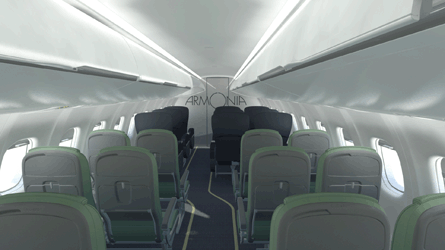When ATR -600s make their first revenue flights during the second half of 2011, passengers might not notice the aircraft's enhanced take-off weight payload and hot-and-high performance compared with the -500 it replaces. But what they will not miss is the all-new interior, conceived for comfort and lightweight by Italdesign Giugiaro, the Turin-based design house behind four decades of automotive icons ranging from the Alfa Romeo Alfasud to the Volkswagen Golf.
On show in a full-scale mock-up on the ATR stand, the new "Armonia" cabin employs new materials, particularly polycarbonate to increase knee clearance, while increased under-seat storage capacity and redesigned overhead bins increase the total carry-on luggage capacity by 30%.
The overhead bins benefit in two ways. One, says ATR technical director Carmine Orsi, is a 10% increase in the cross-sectional area. But, significantly, the adoption of polycarbonate structural material allows for a dramatic cleaning-up of the internal structure of the bins, to create a much more continuous space. The result is that 70% of passengers will be able to store a roller case overhead.
 |
|---|
© ATR |
ATR's newly reappointed chief executive Filippo Bagnato is particularly pleased with that capacity to carry roller cases, noting that passengers are getting bigger, and they carry more luggage, so "the regional aircraft cannot be a bottleneck" in its role of feeding passengers to long-haul services.
An all-new LED interior lighting system also features. Lighter weight and lower-power than the system it replaces, it offers colour-changing capability to reduce stress levels in the cabin.
But what will appeal to operators of Armonia-equipped ATR -600s is the cabin's 200kg (440lb) weight reduction over the -500's interior. And, the Armonia cabin is retrofittable to -500s, as the two models retain the same interface with the cabin structure. For ATR, this retrofitability is a policy, both for "pure business purposes and to protect the investment of our customers", says Bagnato.
Three seats, manufactured by Geven in Naples, are all exclusive to ATR and offer an optional two-class cabin configuration. The "Classic" seat weighs less than 10kg. Offering slightly greater comfort and 4in (10.2cm) recline is the "Prestige" seat, while the "Business" seat features a 7in recline. All offer increased knee room over current seats by, for example, moving the magazine storage pouch to the top of the seat back.
The ATR-Guigiaro collaboration on the Armonia interior project goes back three-and-a-half years, with the past two years spent in detailed design with a focus on weight reduction. On a pre-Farnborough visit to the Italdesign headquarters at Moncalieri, just outside Turin, Bagnato - referring to the display of automotive icons like the DeLorean and Alfa Romeo Brera and design studies for marques ranging from Aston Martin, Ferrari and Lamborghini to Proton, not to mention industrial designs for Nikon cameras, Indesit washing machines, Microsoft X-Box controllers and even a basketball - says: "What you've seen is enough to explain why we chose to work with Giugiaro."
On the importance of design in international markets, Bagnato stresses that technology is just a tool: "Real innovation is in the brain". And, he adds: "The Renaissance is not something that's been forgotten, at least not in Italian design."
As for Giorgetto Giugiaro himself, creative design "must be kept humble", especially where safety is paramount. But, he says, to work on an aircraft project - including "its hedonistic aspects" - is the realisation of a childhood dream.
Source: Flight Daily News



















